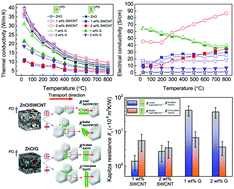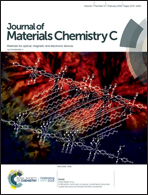Orientation dependent physical transport behavior and the micro-mechanical response of ZnO nanocomposites induced by SWCNTs and graphene: importance of intrinsic anisotropy and interfaces†
Abstract
Carbon nanotubes (CNTs) and graphene (G) possess superior thermal transport properties, large electron mobility, and excellent mechanical properties. However, their intrinsic transport and mechanical anisotropy can potentially have significant consequences for a composite system. We show in this work that adding these “high-performance” carbon materials may not necessarily improve certain properties as expected. We synthesize a series of SWCNT/ZnO and G/ZnO bulk nanocomposites using spark plasma sintering. Electron microscopy investigations reveal that SWCNTs and graphene prefer to align in the plane normal to the pressing direction. We find that the thermal conductivity and electron mobility along the sample cross-sectional direction of SWCNT/ZnO and G/ZnO are substantially lower than those of pure ZnO. The thermoelectric power factor and the figure of merit also exhibit strong orientation dependence. Four types of thermal interfaces (ZnO/SWCNTAxial, ZnO/SWCNTRadial, ZnO/GIn-plane, and ZnO/GCross-plane) exist in these nanocomposites, and their corresponding interfacial thermal (Kapitza) resistance can differ by one order of magnitude. These results provide important implications for thermal management materials where CNTs and graphene are often chosen as thermal fillers to improve heat conduction and dissipation. The noticeable orientation dependence of micro-indentation hardness and fracture toughness observed in some nanocomposites implies the intrinsic mechanical anisotropy in SWCNTs and graphene. Our findings suggest that for a variety of energy, functional, and structural applications, the intrinsic anisotropy, alignment and arrangement of these low-dimensional carbon materials, as well as the carbon/matrix interfaces formed in the composite microstructure, are important factors to be considered and optimally controlled to achieve the desired performance.



 Please wait while we load your content...
Please wait while we load your content...